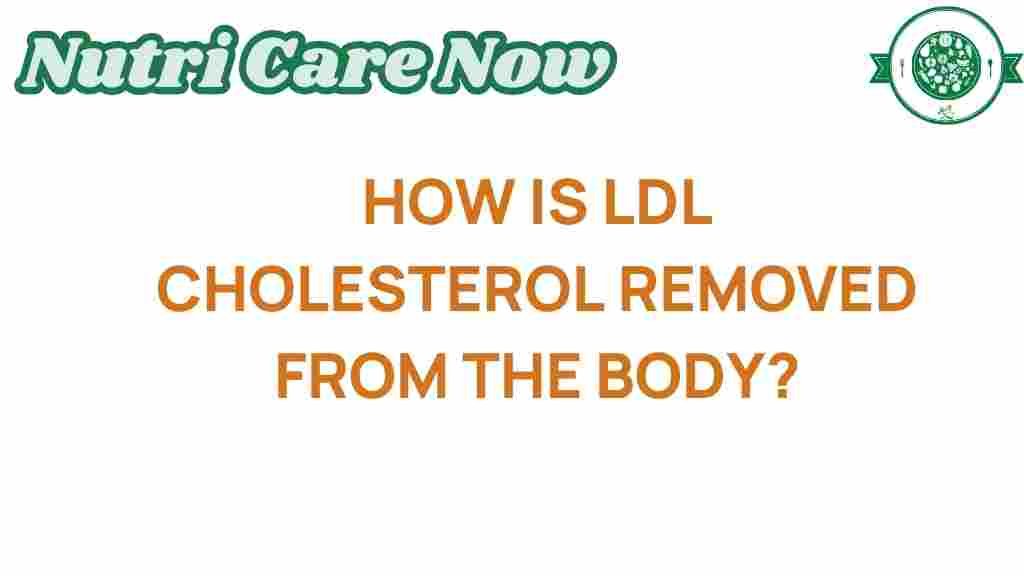Unveiling the Mystery: How LDL Cholesterol Is Cleared from Your Body
When it comes to understanding heart health, one of the most discussed topics is LDL cholesterol. Often referred to as “bad” cholesterol, LDL cholesterol plays a critical role in the body but can contribute to heart disease when levels become too high. In this article, we will delve into how LDL cholesterol is cleared from your body, its impact on health and wellness, and the lifestyle changes you can make to support cholesterol removal and overall heart health.
What is LDL Cholesterol?
LDL cholesterol, or low-density lipoprotein cholesterol, is one of the two main types of cholesterol found in your body. It transports cholesterol from the liver to the cells and tissues, where it is used for various biological functions. However, when there is an excess of LDL cholesterol, it can lead to plaque buildup in the arteries, increasing the risk of heart disease.
The Importance of Cholesterol Removal
Effective cholesterol removal is crucial for maintaining optimal health and preventing diseases. Here’s why:
- Heart Disease Prevention: High levels of LDL cholesterol are directly linked to the development of cardiovascular diseases.
- Enhanced Blood Circulation: Lowering LDL cholesterol levels improves blood circulation and reduces the risk of blood clots.
- Overall Wellness: Maintaining a healthy balance of cholesterol contributes to overall wellness and longevity.
The Process of LDL Cholesterol Clearance
Understanding how LDL cholesterol is cleared from your body involves recognizing several key processes:
1. The Role of the Liver
The liver is the primary organ responsible for cholesterol removal. It produces bile acids that help digest fats and cholesterol. Here’s how it works:
- The liver converts excess LDL cholesterol into bile acids.
- These bile acids are then stored in the gallbladder or secreted into the intestines to aid in digestion.
- Some bile acids are reabsorbed into the bloodstream, while the rest are excreted in the stool, effectively removing cholesterol from the body.
2. The Role of HDL Cholesterol
High-density lipoprotein (HDL) cholesterol is often referred to as “good” cholesterol. It plays a significant role in cholesterol removal by:
- Transporting excess cholesterol from the arteries back to the liver.
- Facilitating the conversion of cholesterol into bile acids for removal.
3. The Impact of Diet on Cholesterol Levels
Your diet directly influences cholesterol levels in your body. Here are some dietary choices that promote cholesterol removal:
- Increase Soluble Fiber: Foods high in soluble fiber, like oats, beans, lentils, and fruits, can help lower LDL cholesterol levels.
- Healthy Fats: Incorporating healthy fats from sources like avocados, nuts, and olive oil can improve your lipid profile.
- Avoid Trans Fats: Reducing intake of trans fats found in processed foods helps prevent LDL cholesterol buildup.
4. Lifestyle Changes for Better Cholesterol Management
Adopting a heart-healthy lifestyle is essential for cholesterol removal and overall well-being. Consider these lifestyle changes:
- Regular Exercise: Engaging in regular physical activity can help raise HDL cholesterol levels and lower LDL cholesterol levels.
- Avoid Smoking: Quitting smoking improves HDL cholesterol levels and enhances heart health.
- Maintain a Healthy Weight: Achieving and maintaining a healthy weight can significantly impact cholesterol levels.
5. Medication and Medical Interventions
In some cases, lifestyle changes may not be enough to manage high LDL cholesterol levels. Healthcare providers may recommend:
- Statins: Medications that lower LDL cholesterol levels by reducing the liver’s production of cholesterol.
- Bile Acid Sequestrants: These medications help remove cholesterol from the bloodstream by binding bile acids.
- PCSK9 Inhibitors: A newer class of injectable medications that can significantly lower LDL cholesterol levels.
Troubleshooting LDL Cholesterol Issues
If you are struggling with high LDL cholesterol levels despite your best efforts, consider the following troubleshooting tips:
1. Monitor Your Cholesterol Levels
Regular screening of your cholesterol levels can help you track your progress and make necessary adjustments. Aim for a lipid panel every 4-6 years if you’re healthy, or more frequently if you have risk factors.
2. Evaluate Your Diet
Keep a food diary to identify dietary habits that could be contributing to high LDL cholesterol. Focus on reducing saturated fats and eliminating trans fats.
3. Review Your Medication
If you are on cholesterol-lowering medication, discuss your treatment plan with your healthcare provider to ensure optimal management of your cholesterol levels.
4. Seek Professional Guidance
Consider consulting a registered dietitian or nutritionist for personalized dietary recommendations that cater to your health needs.
Conclusion
Understanding how LDL cholesterol is cleared from your body is essential for maintaining heart health and preventing disease. By focusing on cholesterol removal through diet, lifestyle changes, and when necessary, medication, you can effectively manage your LDL cholesterol levels.
Making informed choices about your health will not only enhance your blood circulation but will also contribute to your overall wellness. Remember, prevention is always better than cure. For more information on heart health and cholesterol management, check out this comprehensive guide.
Start today by evaluating your lifestyle, making necessary adjustments, and taking proactive steps towards a healthier heart and a better quality of life.
This article is in the category Health and created by NutriCareNow Team
